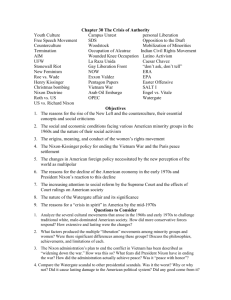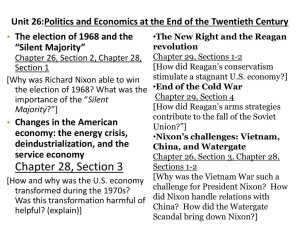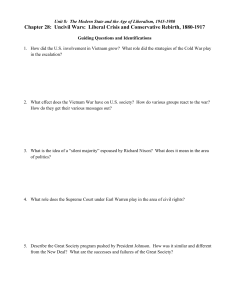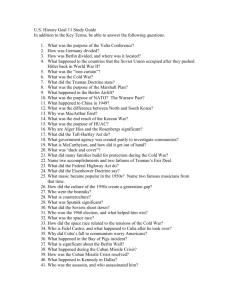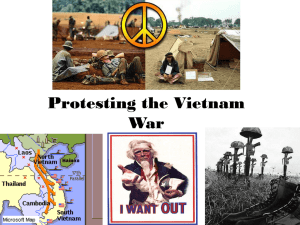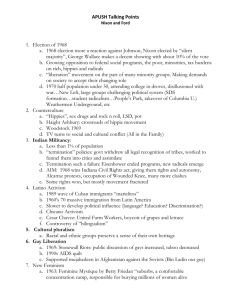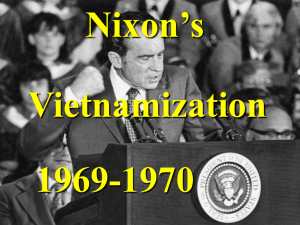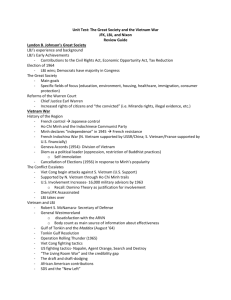Lecture 29, The War at Home, the War Abroad
advertisement
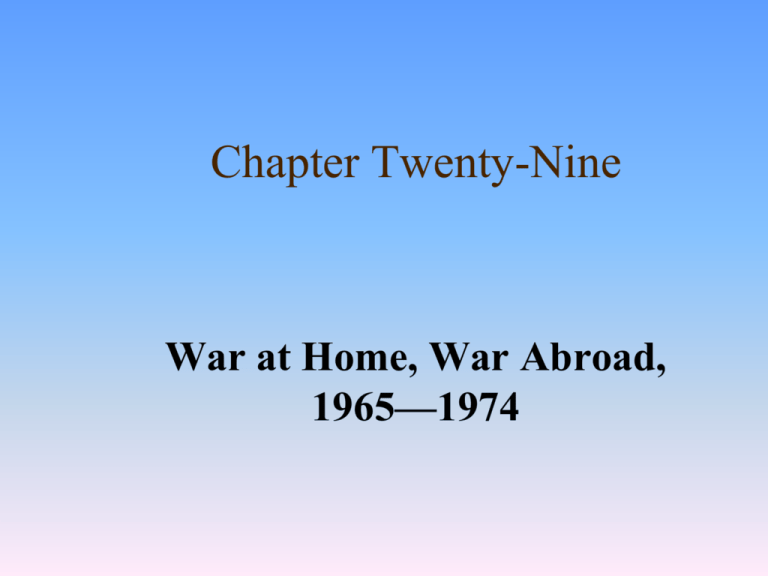
Chapter Twenty-Nine War at Home, War Abroad, 1965—1974 Part One: Introduction Chapter Focus Questions How and why was U.S. involvement in the war in Vietnam widened? What was the “sixties generation” and what was its role in the antiwar movement? How did poverty contribute to the urban crisis? What characterized the election of 1968? What contributed to the rise of “liberation” movements? What characterized the Nixon presidency and how did the Watergate conspiracy arise? Part Two: Uptown, Chicago, Illinois Chicago In 1964, a small group of college students tried to help residents in a poor Chicago neighborhood. The activists were members of Students for a Democratic Society. Founded by white college students, SDS initially sought reform and grew by 1968 to have 350 chapters and between 60,000 and 100,000 members. Efforts to mobilize the urban poor were unsuccessful, but SDS members helped break down isolation and strengthened community ties. By 1967, SDS energies were being directed into protests against the widening war in Vietnam. Part Three: Vietnam: America’s Longest War Johnson’s War Escalated war. Johnson sent large numbers of troops. Search-and-destroy missions. Chemical warfare. Havoc on people, land. LBJ committed to war of attrition. The Credibility Gap Johnson kept his decisions secret. He distorted accounts of military actions. Media questioned the war. Americans questioned LBJ’s handling of the war. Democratic senators led by J. William Fulbright opposed Johnson. Part Four: A Generation in Conflict “The Times They Are A-Changin’” All ages protested war—young stood out. Early campus protests at Berkeley--free speech. San Francisco “Summer of Love.” Woodstock. The Woodstock Festival, promoted as “3 Days of Peace and Music,” attracted more than 450,000 people to the rain-soaked pasture of Max Yasgur’s New York farm. The huge rock concert, staged in August 1969, became a landmark of the counterculture. SOURCE:The Image Works CDOMOOO2. FIGURE 29.4 Public Opinion on the War in Vietnam By 1969 Americans were sharply divided in their assessments of the progress of the war and peace negotiations. The American Institute of Public Opinion, founded in 1935 by George Gallup, charted a growing dissatisfaction with the war in Vietnam. SOURCE:The Gallup Poll:Public Opinion,1935 –74 (New York:Random House,1974),p.2189. Campus Protest in Global Perspective Map: Antiwar Protests From Campus Protests to Mass Mobilization War effort and universities’ roles in war-related research. Student strikes. Public opinion polarized. Massive anti and pro-war rallies. Nonviolent/violent protests erupted at draft boards. African American troops in Vietnam, 1970. Serving on the front lines in disproportionate numbers, many black soldiers echoed the growing racial militancy in the United States and increasingly chose to spend their off-duty time apart from white soldiers. SOURCE:Mark Jury, The Vietnam Photo Book . Teenage Soldiers Cultural attitudes of protesters found in GI counterparts. Latinos and African-Americans disproportionate draftees. Soldiers grew bitter over government lies. Society shunned returning GIs. The war in Vietnam contributed to the growing racial militancy in the United States. African Americans served on the front lines in Vietnam in disproportionate numbers, and many came to view the conflict as a “white man’s war.” SOURCE:J ames Meredith march through Mississippi.© 2001 Matt Herron c/o Mira.com. Part Five: Wars on Poverty An American Profile: Life Expectancy A racial divide existed on life expectancy. FIGURE 29.1 Comparative Figures on Life Expectancy at Birth by Race and Sex, 1950–70 Shifting mortality statistics suggested that the increased longevity of females increasingly cut across race lines, but did not diminish the difference between white people and black people as a whole. An American Profile: Infant Mortality Poverty helped create a racial divide on infant mortality FIGURE 29.2 Comparative Figures on Infant Mortality by Race, 1940–70 The causes of infant mortality such as inadequate maternal diets, prenatal care, and medical services were all rooted in poverty, both rural and urban. Despite generally falling rates of infant mortality, nonwhite people continued to suffer the effects more than white people. An American Profile: Poverty Michael Harrington’s The Other America, awareness increased. LBJ’s “an unconditional war on poverty.” Chart: Percentage of Population Below Poverty Level FIGURE 29.3 Percent of Population Below Poverty Level, by Race, 1959–69 Note: The poverty threshold for a nonfarm family of four was $3,743 in 1969 and $2,973 in 1959. SOURCE:Congressional Quarterly,Civil Rights:A Progress Report , 1971,p.46. The Great Society Office of Economic Opportunity. The Job Corps failed. Community Action Agencies threatened those in power. Legal Service Program and Head Start made differences. Great Society opposed to income redistribution. Most social spending went to non-poor via Medicare. 1970 study concluded war on poverty barely scratched surface. Crisis in the Cities Cities became segregated centers of poverty. Pollution surrounded large minority populations. Urban black frustrations resulted--100 riots. Between 1965 and 1968, racial tensions exploded into violence in more than seventy-five cities. Unlike earlier episodes of racial violence, which often took the form of clashes between black and white residents over contested neighborhoods, the riots of the 1960s were more often attacks by residents against retail establishments and property owned primarily by whites. Most deaths and injuries resulted from confrontations between police and rioters, not from fighting between black and white residents. This photograph, taken in 1967, shows police officers arresting suspected looters in Newark, New Jersey, where twenty-three people were killed in the course of the uprising. SOURCE:Bettmann/CORBIS BE020706. Urban Uprisings Map: Urban Uprising A presidential commission blamed the rioting on white racism, poverty, and police brutality, and recommended massive social reforms. MAP 29.1 Urban Uprisings, 1965–1968 After World War II urban uprisings precipitated by racial conflict increased in African American communities. In Watts in 1965 and in Detroit and Newark in 1967, rioters struck out at symbols of white control of their communities, such as white-owned businesses and residential properties. Part Six: 1968 MAP 29.2 The Southeast Asian War The IndoChinese subcontinent, home to long-standing regional conflict, became the center of a prolonged war with the United States. The Tet Offensive Map: The Southeast Asian War January 30, 1968 Tet Offensive. Credibility of American officials shattered. U.S. military victory, media reports triggered antiwar protests. LBJ declared a bombing halt. Announced he would not seek reelection. Martin Luther King, Jr. 1968, Martin Luther King broke with LBJ on Vietnam. Massive Poor People’s Campaign. MLK assassinated in Memphis. Rioting broke out in over 100 cities. “Martin Luther King,” Robert Kennedy said when he heard the news of the assassination of the civil rights leader, “dedicated his life to love and to justice for his fellow human beings, and he died because of that effort.” The funeral service for King was held in the Ebenezer Baptist Church in Atlanta on April 7, 1968. SOURCE:“Walk down West Hunter Street,Atlanta .” © James L..Amos/CORBIS (JA 004098). The Democratic Campaign Polarization split the Democrats. Robert Kennedy and Eugene McCarthy sought anti-war vote. Kennedy appeared unbeatable, but was assassinated. Hubert Humphrey won the nomination from divided party. The Democratic Convention was scene of riots. In 1968, Richard J. Daley had been elected major of Chicago four times and held power as a traditional city boss. In December of that year, the National Commission on Violence released a report that concluded that Chicago police, acting under Mayor Daley’s brazenly announced a 22 percent salary increase for members of the city’s police and fire personnel. This painting, by the popular illustrator Bernard Perlin, depicts the protest against Mayor Daley’s role during the Democratic Convenction. SOURCE:Bernard Perlin,Mayor Richard Daley,1968 .Collection of Philip J.and Suzanne Schiller,American Social Commentary Art, 1930 –70.Library of Congress. Part Seven: The Politics of Identity Black Power Generational divisions marked the civil rights movement. Younger African Americans turned to Black Power. Black Panthers reflected the growing militancy. Racial pride grew during the late 1960s. A renewed interest in African heritage and culture. Sisterhood is Powerful Women began to demand equal rights. Women identified their movement as one of liberation. Diverse and comprehensive women’s rights agenda emerged White middle-class women. On August 26, 1970, to mark the fiftieth anniversary of the passage of the Nineteenth Amendment, women nationwide staged demonstrations for women’s rights. The young women in this photograph gathered in Central Park, New York, in the largest demonstration ever held for women’s rights. Proposed by Representative Bella Abzug and designated by Congress in 1971, Women’s Equality Day is celebrated every year on August 26. SOURCE:Jesse-Steve RoseThe Image Works BROS0031000. Gay Liberation Several openly gay organizations had emerged after WWII. Stonewall Riot in New York City in 1968 Galvanized Gay Liberation Front. Large minority of homosexuals “came out”. The Chicano Rebellion Chicano pride and nationalism Mexican Americans push for land and social reforms. Cesar Chavez organized United Farm Workers. Labor activist Cesar Chavez spearheaded the organization of Chicano agricultural workers into the United Farm Workers (UFW), the first successful union of migrant workers. In 1965, a strike of grape pickers in the fields around Delano, California, and a nationwide boycott of table grapes brought Chavez and the UFW into the media spotlight. Like Martin Luther King Jr., he advocated nonviolent methods for achieving justice and equality. SOURCE:© Paul Fusco//Magnum photo (NYC40062). Red Power Map: Major Indian Reservations Indian activists took over Wounded Knee. Indian Renaissance led to many new books about Indian life. MAP 29.3 Major Indian Reservations, 1976 Although sizable areas, designated Indian reservations represented only a small portion of territory occupied in earlier times. The Asian American Movement Asian Americans embraced a nationalism. Part Eight: The Nixon Presidency The Election of 1968 In 1968, Richard Nixon’s campaign: appealed to voters hostile to the protests, counterculture pledged to undercut liberal programs roll back the Great Society Nixon narrowly defeated Humphrey and George Wallace. MAP 29.4 The Election of 1968 Although the Republican Nixon-Agnew team won the popular vote by only a small margin, the Democrats lost in most of the northern states that had voted Democratic since the days of FDR. Segregationist Governor George Wallace of Alabama polled more than 9 million votes. The massive bombing and ground combat created huge numbers of civilian casualties in Vietnam. The majority killed were women and children. SOURCE:BlackStar/Stockphoto WQXQZ4TN. In 1971 a group of angry veterans create the first memorial to the war, throwing their Purple Hearts and Bronze Stars into a heap before the U.S. Capitol and adding their discharge papers to the pile. AP Wide World Photos. The Vietnam Veterans Memorial carries the 58,132 names of men and women who were killed in Vietnam carved into the highly polished, reflective black granite in the order in which they were killed. The entire installation is below ground-level and not visible from most parts of the Mall. A replica, the “Moving Wall,” travels to various cities and towns throughout the country. Joyce Naltchayan/Agence France Presse/Getty Images. Editors of the conservative National Review have complained that the memorial focuses on individuals not the war, making “death in war a private matter rather than a sacrifice for collective cause.” In this photograph, a sister touches the name of her brother. The objects left at the wall are carefully preserved in a warehouse in suburban Maryland. Getty Images,Inc. “The Three Fightingmen,” by sculptor Frederick Hart portrays strong, highly masculine soldiers returning from patrol. Positioned facing the wall, the soldiers appear to be gazing at the names on the wall. The sculture was added in 1984 in response to critics who complained that the wall was insufficiently patriotic and too unlike conventional war monuments, which usually depicts heroic images of military men. Getty Images,Inc. The Vietnam Women’s Memorial, designed by Glenna Goodacre and dedicated in 1993, is the first national memorial to female veterans. The bronze sculpture, which stands about 300 feet from the wall, honors the ten thousand women, military and civilian, who served with the U.S. armed forces in Vietnam. Sonda Dawes/The Image Works. Nixon’s War Nixon promised to bring “peace with honor” to Vietnam. Nixon and Henry Kissinger, believed defeat would destroy global leadership. Nixon spoke of a phased withdrawal. Widened the war by invading Cambodia. Four deaths at Kent State, two at Jackson State. Nixon accepted a peace settlement. South Vietnam fell. Chart: U.S. Military Forces and Casualties On Monday, May 4, 1970, after a weekend of antiwar demonstrations against the invasion of Cambodia, Ohio National Guardsmen fired 67 bullets into a crowd of students, killing four and wounding nine others on the campus of Kent State University. As news of the killings spread, students at hundreds of colleges and universities turned out in mass demonstrations to protest widening the war in Southeast Asia and the increasing violence on campus. Approximately 5 million students joined the national student strike, boycotting classes for the remainder of the week. As news of the Kent State “massacre” spread to Vietnam, some U.S. troops refused orders to invade Cambodia; others wore black armbands to demonstrate their solidarity with students at home. SOURCE:Getty Images Inc./Hulton Archive Photos PAL AADXNVWO. FIGURE 29.5 U.S. Military Forces in Vietnam and Casualties, 1961–81 The United States government estimated battle deaths between 1969 and 1973 for South Vietnamese troops at 107,504 and North Vietnamese and Vietcong at more than a half-million. Although the United States suffered fewer deaths, the cost was enormous. SOURCE:U.S.Department of Defense,Selected Manpower Statistics, annual and unpublished data;beginning 1981,National Archives and Records Service,“Combat Area Casualty File ” ((3-330-80-3). Foreign Relations Nixon opened relations China. Relations with the Soviet Union improved. Kissinger negotiated a temporary lull Mideast War. Domestic Policy Despite his conservatism, Nixon: supported guaranteed income to replace welfare imposed a wage and price freeze to hold down inflation Opposition to school busing Conservative Supreme Court appointments. Part Nine: Watergate Conspiracy and The Age of Dirty Tricks Nixon’s foreign policy included secret interventions. Regimes propped up or destabilized in Asia, Africa, and Latin America. Formed inner circle to keep information from the public. 1972, Democrats nominated George McGovern. The Nixon reelection committee ran a dirty-tricks campaign. Break-in at the Democratic headquarters at Watergate. The Fall of the Executive The White House covered up Watergate involvement. Wash Post followed the evidence back to the Oval Office. Nixon fired the special Watergate prosecutor Nixon made tapes of White House conversations. Nixon resigned to avoid impeachment. Richard Nixon bid a final farewell to his White House staff as he left Washington DC on August 9, 1974. The first president to resign from office, Nixon had become so entangled in the Watergate scandal that his impeachment appeared certain. He was succeeded by Vice-President Gerald Ford. After taking the oath of office later that day, President Ford remarked that the wounds of Watergate were “more painful and more poisonous than those of foreign wars.” SOURCE:Bettmann/Corbis BE 023919. Part Ten: Conclusion
